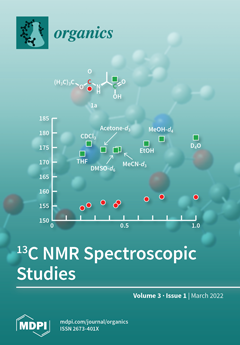Site-specific introduction of isotopes in tetrapyrrole macrocycles provides the foundation for probing physicochemical features germane to photosynthetic energy-transduction processes, but has chiefly been done with porphyrins rather than the more biologically relevant hydroporphyrin analogues of native photosynthetic pigments. A prior study incorporated pairwise
[...] Read more.
Site-specific introduction of isotopes in tetrapyrrole macrocycles provides the foundation for probing physicochemical features germane to photosynthetic energy-transduction processes, but has chiefly been done with porphyrins rather than the more biologically relevant hydroporphyrin analogues of native photosynthetic pigments. A prior study incorporated pairwise
13C or
15N atoms in the skeleton of a bacteriochlorin containing a gem-dimethyl group in each pyrroline ring. Here, a complementary effort is reported that installs deuterium atoms in substituents at the perimeter of a bacteriochlorin. Thus, perdeuteriated 3-methyl-2,4-pentanedione was converted in an 8-step synthesis via the intermediacy of
tert-butyl 5-formyl-3,4-bis(trideuteriomethyl)pyrrole-2-carboxylate to the 2,3,12,13-tetrakis(trideuteriomethyl)-8,8,18,18-tetramethylbacteriochlorin (
BC-2). The fidelity of isotope substitution was maintained throughout the synthesis. Resonance Raman spectroscopy of the copper chelate (
CuBC-2) revealed that addition of the four β-pyrrolic substituents alone is not sufficient to account for the vibronic complexity observed for the copper chelate of bacteriochlorophyll
a (
CuBChl a). The increased vibronic activity exhibited by the natural pigments and
CuBChl a must arise from the increased structural complexity of the macrocycle.
Full article





